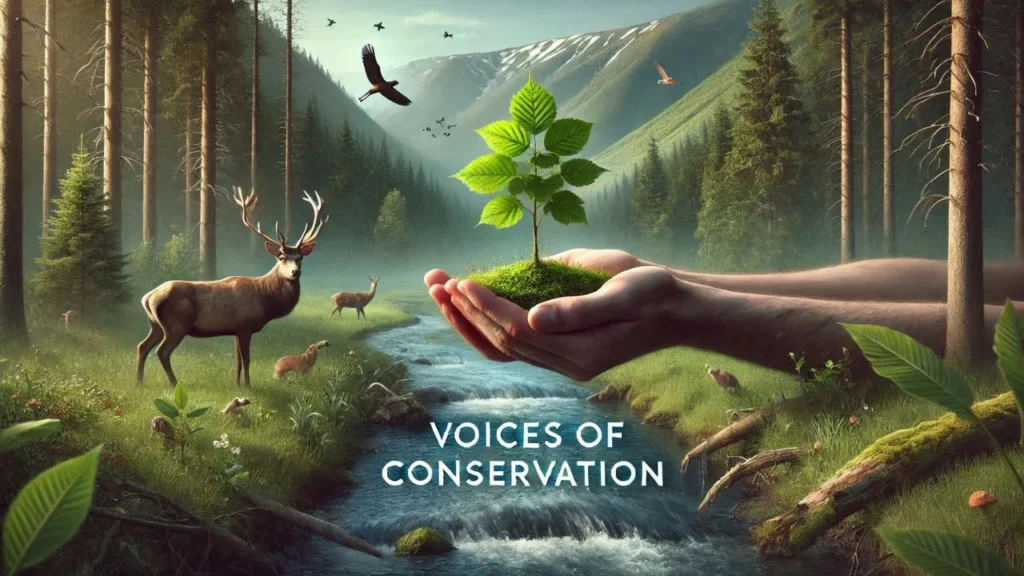Conservation efforts have become a global priority as the environment faces growing threats from climate change, deforestation, and species extinction. Organizations like From Voicesofconservation.org Blog are working tirelessly to raise awareness and offer solutions to preserve our planet’s natural resources for future generations. This blog delves into the essence of conservation, highlights the pivotal role of such organizations, and shares user experiences that underscore the need for action.
Introduction to Conservation
Conservation is the act of preserving, preserving or protecting ecosystems, wildlife and natural resources. As we face environmental challenges, the urgent need for conservation has become more prominent. The actions we take today can shape the future of our planet, ensuring that the delicate balance of ecosystems is maintained.
What is “From Voicesofconservation.org Blog”?
From Voicesofconservation.org Blog is an online platform and organization dedicated to environmental advocacy and conservation efforts worldwide. Their mission is to amplify the voices of individuals, communities, and conservationists, uniting people with the common goal of protecting the planet.
Through blogs, resources, and community engagement, Conservation Voices helps spread awareness and encourages actionable solutions to pressing environmental issues.
The organization highlights stories from people on the front lines of conservation, offering insights into the challenges faced by ecosystems and the success stories of restoration efforts.
Why Conservation Efforts Matter
The importance of conservation cannot be overstated. It plays an important role in maintaining biodiversity, ensuring that ecosystems are resilient and able to provide essential services such as clean air, water and fertile soil. Without conservation, we risk losing the foundations that sustain human life.
Key reasons why conservation is essential include:
- Biodiversity Protection: Conserving natural habitats ensures that diverse species can thrive, supporting food chains and healthy ecosystems.
- Climate Regulation: Forests and oceans play a significant role in regulating the earth’s climate by absorbing carbon dioxide and providing oxygen.
- Sustainable Development: Conservation promotes the responsible use of natural resources, ensuring that future generations have access to them.
- Cultural and Aesthetic Value: Many indigenous cultures are deeply connected to nature, and conservation helps preserve their heritage and traditions.
Case Study: A Personal Journey into Conservation
One of the From Voicesofconservation.org Blog blog readers, Sarah, shares her experience of becoming involved in conservation efforts after witnessing the harmful effects of deforestation in her local community. Sarah, a high school teacher, described how she took her students on a field trip to a nearby forest, only to find that large sections had been cleared.
Here’s her story:
“It was shocking. The beautiful forest that I had known since childhood was disappearing. The students were just as devastated as I was, and I knew I had to do something. I started researching conservation organizations and came across Voices of Conservation. Their resources and support helped me organize a local initiative. We partnered with a tree-planting project, and over the last two years, we’ve replanted several acres. My students are now more aware of environmental issues, and I’m proud to say that our small contribution is part of a larger, global effort.”
Sarah’s experience illustrates the power of individual action. By leveraging the tools and knowledge provided by conservation platforms, ordinary people can make extraordinary impacts.
Core Focus Areas of Conservation
Conservation efforts span multiple domains, each critical to preserving different aspects of our natural environment. Below are some of the key areas that From Voicesofconservation.org Blog emphasizes in its initiatives:
Wildlife Conservation
Wildlife conservation aims to protect animal species and their habitats. Many species are facing extinction due to human activities, including poaching, habitat destruction, and climate change. Conservation organizations work to protect endangered species by enforcing laws, creating wildlife sanctuaries, and supporting breeding programs.
Key Initiatives:
- Protecting endangered species like tigers, elephants, and rhinos.
- Anti-poaching laws and patrolling efforts.
- Restoring natural habitats to support wildlife recovery.
Forest Preservation
Forests are often referred to as the lungs of the earth, as they play a vital role in carbon sequestration and oxygen production. Deforestation, driven by agriculture, logging, and urban development, is a major environmental concern. Conservationists focus on reforestation efforts, sustainable land use, and the protection of existing forests.
Key Initiatives:
- Promoting sustainable logging practices.
- Reforestation and afforestation projects.
- Education on the benefits of forest ecosystems for local communities.
Marine Ecosystem Protection
Marine ecosystems are under threat from pollution, overfishing, and climate change. The health of our oceans is directly linked to the survival of many species, both aquatic and terrestrial. Marine conservation efforts focus on protecting coral reefs, reducing plastic waste, and creating marine protected areas.
Key Initiatives:
- Banning single-use plastics to reduce ocean pollution.
- Protecting coral reefs and mangroves.
- Sustainable fishing practices to prevent overfishing.
How You Can Get Involved
Conservation is not just the responsibility of governments or large organizations; individuals can also make a significant difference. Here are several ways you can contribute to conservation efforts, inspired by resources from From Voicesofconservation.org Blog:
- Join a Local Conservation Group: Many communities have local conservation organizations that welcome volunteers.
- Reduce Your Carbon Footprint: Small changes like using energy-efficient appliances, reducing waste, and opting for public transportation can add up to a significant impact.
- Support Ethical Brands: Purchase products from companies that use sustainable practices and contribute to conservation efforts.
- Educate Others: Share your knowledge of conservation with friends, family, and colleagues. Raise awareness about environmental issues through social media or local events.
The Role of Technology in Conservation
Technology plays an increasingly important role in conservation efforts. From satellite imaging to monitor deforestation to AI models that predict endangered species’ habitats, technological innovations are making conservation more effective and data-driven. Conservation organizations, including From Voicesofconservation.org Blog, are using these tools to create actionable insights and scalable solutions.
Examples of Technology in Conservation:
- Drones: Used for monitoring wildlife and reforestation efforts.
- GIS Mapping: Helps track habitat destruction and biodiversity loss.
- Artificial Intelligence: Predicts future threats to ecosystems by analyzing current environmental data.
Conclusion
Conservation is an urgent, global responsibility that requires action from all of us. Whether through individual efforts, community involvement, or supporting organizations like From Voicesofconservation.org Blog, we all have a role to play. The future of our planet depends on the conservation efforts we implement today. By staying informed and getting involved, we can help preserve the environment for future generations.
Remember, the smallest actions can lead to the biggest impacts. Like Sarah’s story, your conservation journey could begin with a single step—whether it’s planting a tree, reducing waste, or educating others on environmental issues. Together, we can protect our planet and ensure that its beauty and resources endure for years to come.
FAQs
What is the main goal of conservation?
The main goal of conservation is to protect natural resources and biodiversity, ensuring that ecosystems can continue to support life and provide essential services like clean water, air, and fertile soil.
How can I contribute to conservation efforts?
You can contribute by joining local conservation groups, reducing your carbon footprint, supporting ethical brands, and educating others about the importance of conservation.
Why is wildlife conservation important?
Wildlife conservation is crucial for maintaining biodiversity, which in turn supports ecosystem resilience. Protecting endangered species also ensures that future generations can enjoy the same natural beauty and diversity that we do today.
What is Voices of Conservation?
Voices of Conservation is an organization and online platform that promotes environmental awareness, shares stories from conservationists around the world, and provides resources for those looking to get involved in conservation efforts.
What technologies are used in conservation?
Technologies such as drones, satellite imaging, GIS mapping, and artificial intelligence are used to monitor ecosystems, track biodiversity loss, and predict future environmental threats.







